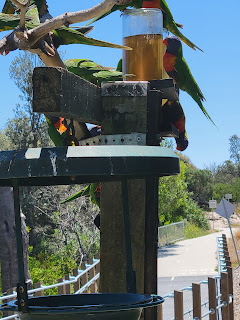A comment on my blog by Darla M Sands sent me googling. In my Christmas Day detail post, I mentioned Tradie Brother's home air cooling system with a brief description.
So this is to educate you foreign types about how we stay cool in Australia.
There are two types of cooling, refrigerated and water cooling. Refrigerated is the most effective as it cools and dries the air of humidity. It is what you will have in your motor car. It does cost a good bit to run though and while we have one adequate unit to cool our place, any larger we would need a second unit. Our friend in Kula Lumpur has three units to cool his smaller apartment and admits one is a bit of spare in case one breaks down. That says something about the climate in KL.
In larger more outer suburban houses there might be six units, small ones for each bedroom and a couple of large ones for the living areas and the kitchen. It is expensive enough for us to run one unit. Who knows what six units running would cost.
A much cheaper alternative to cool large homes is evaporative cooling and that is what my Tradie Brother has, ducted to each bedroom, kitchen and living rooms. Darla M Sands sent me off searching to see if swamp coolers are the same thing, and they are. I continue to learn stuffs.
Early Australian settlers noticed indigenous people using porous kangaroo skin bags to carry water. The passing breeze with the slightly porous skin kept the water cool. The settlers adapted this to similar but using porous canvas. I remember my grandfather's canvas water bag and motorists used to hang them in front of their car radiators to keep water cool.
From that knowledge we move on to Coolgardie safes, where the life of perishable food (and maybe bottles of beer) was extended by having hessian hanging on the sides of a cabinet and extending to the top where it sat in a water tray and the wick effect drew the water down the hessian. The safe would be hung outside in a breeze and keep perishables for much longer than usual.
Moving on to the 1970s, my father and step mother bought a water cooler on wheels. It had straw filled panels on three sides and a fan. We had to feed it water using a bucket, maybe ten litres at a time, well a bucket full of water. The water was pumped to the top and dripped down through the straw panes. It worked well enough and was somewhat cooling.
Now on to the 80s and the early 21st century, whole homes were cooled by water evaporative coolers. I remember visiting the home of a distant relative of Step Mother's in Griffith, NSW. The water cooling was lovely and cool and I guess Griffith only has dry heat. The local club had proper refrigerated air conditioning.
In the 80s or early 90s in Melbourne water cooling began appearing in Melbourne, with roof top units appearing atop so many outer suburban houses. This version had a plumbed water supply and a drain and of course a powerful fan but still it was the same principal. That is blowing air through a wet material, just like the Aborigines kangaroo skin water bags worked.
Contrary to refrigerated air con, it is suggested you open a window or two in your home if you have evaporative cooling.
So look, evaporative cooling is not bad unless the weather is humid whereby it totally fails, and that happens rarely in Melbourne. If you are in humid climate and try to use evaporative cooling, your wallpaper will peel off, your wardrobe contents will grow mould, fungus will grow between your toes and you will come down with pneumonia and end up in hospital, where there will be refrigerated air conditioning. .
However, with the price of gas, in the usual middle to outer suburban areas where ducted gas heating is falling from favour because of the cost, hence the swing to reverse cycle air conditioning which heat and cool with dry air, too dry at times. What some of the McMansions must cost to heat and cool is barely imaginable. This great article describes McMansions so well if you don't know what they are. There are smaller versions of McMansions too.
A typical evaporative home air cooling unit that can be seen in middle to outer newer suburban housing.



.png)




.jpg)
.jpg)

.jpg)
.jpg)
.jpg)
.jpg)
.jpg)
.jpg)
.jpg)
.jpg)
.jpg)
.jpg)
.jpg)
.jpg)
.jpg)


.jpg)
